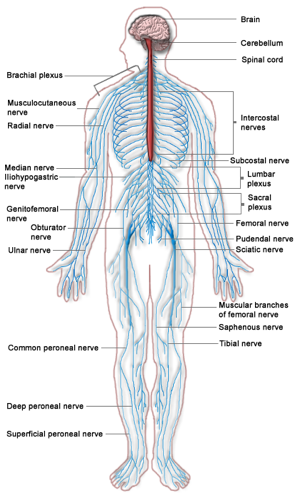
The Nervous System
last authored: Sept 2009, Dave LaPierre
last reviewed:
Introduction
The nervous system is the control and processing system of the body, likely representing the most complicated structure in the universe. The central nervous system (CNS) is composed of the brain and spinal cord, while the peripheral nervous system contains nerves carrying signals to and from the CNS.
The CNS and nerves are composed of cells called neurons which are arranged into neural circuits. Signals are propogated via action potentials and between neurons via neurotransmitters. The support cells of the nervous system are called glial cells.
The brain and spinal cord are the site of processing, integration, and output of the nervous system. Specific components of the brain include:
- cortex: processing and outputs for motor and sensory functions; higher order brain activities
- cerebellum: skilled coordination of activity
- brain stem: essential functions for life (heart rate, breathing, etc); connects rest of brain with spinal cord
- limbic system: memory, emotional regulation
- thalamus: provides connections for motor and sensory pathways
- basal ganglia: coordination and initiation of movement
- cerebrospinal fluid
- hypothalamus
The spinal cord is involved in some processing, though it's major role is in transmitting information bilaterally between the brain and the rest of the body.
Nerves transmit information over distances in both directions.
Spinal nerves are found adjoining the spinal cord, while cranial nerves begin directly from the brain.
The autonomic nervous system controls involuntary, homeostatic functions such as heart rate and digestion. The sympathetic nervous system is responsible for activation - fight, flight, freeze, or sex. The parasympathetic nervous system is responsible for rest-and-digest activities. It also contains the enteric nervous system, regulating the gut.
The somatic nervous system is involved in motor control, as well as sensory systems.
All sensory systems convey four basic types of information - modality, location, intensity, and timing - to generate an internal representation of the world around us. Modality is determined by stimulus energy, both frequency and amplitude. Different types of sensation include:
- bodily senses - touch, pain, temperature, proprioreception, and vibration
- visceral sensation, relayed by the autonomic nervous system, describe hunger, nausea, and visceral pain
- olfaction
- taste
- vision
- hearing
- vestibular system - balance
Meninges
The meninges are the matrix coverings of the brain and spinal cord.
The dura is the tough outer layer of the CNS.
The falx separates the two hemispheres, while the tentorium does something else.
The arachnoid membrane is composed of webs of cells joined by tight junctions. It prevents cerebrospinal fluid from encountering the dura. The arachnoid
The pia is a thin, shiny layer of mesnchymal cells lying directly on the brain and spinal cord. Blood vessels lie outside the pia and carry a sleeve of pia with them as they enter the brain. Pia extends into sulci, such that the entire surface area of the brain is covered with it. Pia does not prevent exchange between the brain extracellular fluid, which bathes neurons, and the cerebrospinal fluid, which exists in the subarachnoid space.
Glial Cells
Meaning 'glue', in Greek, glia are involved in nearly every function of the brain. They fill all the spaces around neurons, with an approximate width of only 0.02 µm between cells.
Glial cells outnumber neurons 100:1 and are responsible for myelinating neurons. Specific types of glial cells include:
Schwann cells envelop the neuromuscular junction.
Oligodendrocytes are present in the central nervous system, and play an active role in myelination. While Schwann cells myelinate single axons, oligodendrocytes can myelinate up to 100 axons each.
Microglial cells perform a different function
Resources and References

